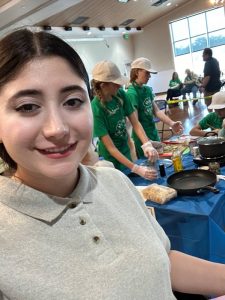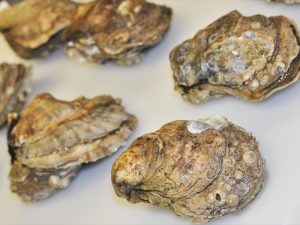 A warm welcome to Razieh Sadat Mirmahdi, the latest guest in our FSHN Research Journeys series, which follows graduate students’ research in the Food Science and Human Nutrition program at The University of Florida. Razieh is a second-year graduate student pursuing her Ph.D. in food science. Her research into eliminating norovirus in cooked oysters will allow consumers to enjoy these shellfish without worrying about norovirus infection.
A warm welcome to Razieh Sadat Mirmahdi, the latest guest in our FSHN Research Journeys series, which follows graduate students’ research in the Food Science and Human Nutrition program at The University of Florida. Razieh is a second-year graduate student pursuing her Ph.D. in food science. Her research into eliminating norovirus in cooked oysters will allow consumers to enjoy these shellfish without worrying about norovirus infection.
Razieh: When it comes to indulging in the culinary pleasures of the sea, few delicacies are as enticing as a plate of oysters. The briny aroma, the tender texture, and the burst of flavor as you take that first bite can be a true delight for the senses. With our research, as you savor the delectable morsel, you will be confident in the safety and wholesomeness of oyster consumption.
In recent decades, the US has witnessed outbreaks linked to consuming raw oysters, which were mainly imported. Contamination likely occurred through harvest from sewage-contaminated waters.1 However, oysters grown in approved waters are generally safe for raw consumption. Like many other foods, cooking is an effective technique to ensure the microbial safety of oysters, but only if done well!
There have been some illnesses with norovirus associated with oysters when they were consumed after heating. Norovirus is a hardy virus and causes millions of illnesses in the US, mainly through the consumption of ready-to-eat foods such as fruits, vegetables, and shellfish. The survival of norovirus in undercooked oysters intrigued my interest in addressing this question to shed light on the complexities surrounding the safety of cooked oysters and ultimately contributing to the enhancement of food safety standards.

Investigating Norovirus in Cooked Oysters
Based on data from the U.S. Census of Aquaculture, the US has witnessed a remarkable surge in oyster consumption. A survey conducted in 2022 showed the most popular oyster preparation method is steaming, with a preference rate of 70.9%. Grilling comes next at 48.4%, followed by raw at 41.9%, and cooked in a recipe alongside other ingredients at 33.4%.2,3 Yet no exact information exists about the specific time and temperature parameters used in these methods in the U.S.

In most cases, applying heat to raw food products effectively reduces foodborne pathogens to safe levels, rendering the food safe for consumption.
According to the CDC, 4.5% of norovirus outbreaks linked to oyster consumption between 1971 and 2021 were associated with cooked oysters (fried, baked, and steamed) attributed to norovirus, which indicates that the products were potentially undercooked that allowed survival of the virus.1 Human norovirus is an environmentally stable and highly infectious virus causing gastrointestinal infections, leading to symptoms like vomiting, diarrhea, and stomach cramps.4 Those individuals who prefer cooked products need to ensure the food has gone through thorough cooking prior to consumption.
To address these challenges, my Ph.D. research aims to establish effective oyster cooking techniques to mitigate norovirus using a quantitative microbial risk assessment (QMRA) framework. By shedding light on this risk, we aim to empower consumers and industry alike to make informed choices when it comes to relishing the culinary delights of oysters.
Starting My Journey to Food Virology at UF
After completing my master’s degree, I set my sights on gaining admission to a renowned university for its excellence in food science. My research led me to the University of Florida, a distinguished institution with a strong reputation in my field. Upon closer examination of their faculty’s research, I was captivated by the work of Dr. Naim Montazeri. His research focuses on critical areas such as the survival and inactivation of human norovirus in agricultural systems, encompassing pre- and post-harvest water, soil, and fresh produce.

Food virology holds immense significance in safeguarding public health, preventing foodborne outbreaks, facilitating global food trade, and upholding consumer trust in the safety of their food supply. The field remains ever-evolving and crucial within food safety and security. Dr. Montazeri’s area of expertise deeply resonated with my academic interests, prompting me to initiate contact with him and enroll at UF.
Studying Norovirus Inactivation in Cooked Oysters
Since cooked oysters have been implicated in norovirus outbreaks, our first step involves identifying current oyster cooking practices in the U.S. through a behavioral survey. We aim to gather comprehensive information regarding the time and temperature parameters used in cooking oysters. Then, I will study the heat inactivation and factors involved in the survival of norovirus in whole oysters using the time and temperature data acquired from our survey to quantify the survival of this virus.
In the final step, we will establish a quantitative microbial risk assessment model for norovirus in cooked oysters. This framework will provide insights into the risks associated with the consumption of undercooked oysters. The results will serve as a valuable resource for consumers, stakeholders, and policymakers to mitigate norovirus in oysters and reduce the risk of foodborne illnesses.

Overcoming Challenges in the Oyster Project
The absence of an effective infectivity assay for human norovirus has necessitated using molecular detection techniques like PCR as the gold standard for its detection and quantification. Human sewage and oyster tissues often contain strong PCR inhibitors, which can reduce amplification efficiencies and produce falsified PCR signals. This inhibition can result in false-negative outcomes when human norovirus concentrations are low. Thus, we employ appropriate extraction and purification methods to accurately detect or quantify human norovirus in complex matrices.
Additionally, measuring the infectivity of human norovirus in the laboratory has proven difficult. The primary detection method, RT-qPCR, cannot distinguish between infectious and non-infectious particles. Consequently, we are using virus surrogates that mimic human norovirus behavior. Cultivable surrogate viruses offer several benefits. However, surrogates may not fully replicate human norovirus’s structural similarity and environmental persistence.
Following this research, our risk assessment project will offer specific guidelines on the optimal time and temperature for safely cooking oysters. Our goal is to protect both stakeholders and consumers, ensuring that oysters are safe and enjoyable for all!
Razieh Sadat Mirmahdi is a second-year graduate student pursuing her Ph.D. in food science, focusing on food virology in the lab of Dr. Naim Montazeri. Beyond her academic endeavors, Razieh holds a master’s level proficiency in preparing traditional Persian dishes. Her skills and passion for fine food have afforded her a unique perspective on the intersection of science and gastronomy.


References
- CDC. 2024. National Outbreak Reporting System Dashboard. Atlanta, Georgia: U.S. Department of Health and Human Services, CDC. https://wwwn.cdc.gov/norsdashboard/ (accessed on June 27, 2024).
- U.S. Department of Agriculture. 2019. Census of Aquaculture (2017). Volume 3, Special Studies Part 2. AC-17-SS-2. Washington, DC: U.S. Department of Agriculture, National Agricultural Statistics Service3. Richardsa S, Vassalosb M, Motallebic M. Factors
- Affecting Consumer Purchasing Decisions and Willingness to Pay for Oysters in South Carolina. Journal of Food Distribution Research. 2022 Jul;53(2):1-25.
- Orenstein R. Gastroenteritis, Viral. In: Encyclopedia of Gastroenterology [Internet]. Elsevier; 2020 [cited 2023 Sep 22]. p. 652–7. Available from: https://linkinghub.elsevier.com/retrieve/pii/B9780128012383659731
Looking for more posts exploring graduate research projects in the FSHN Department at the University of Florida?
Dive into the Research Journeys of other graduate students below.
M.S. Food Science
M.S. Nutritional Sciences
Ph.D. Food Science
Ph.D. Nutritional Sciences
 1
1
